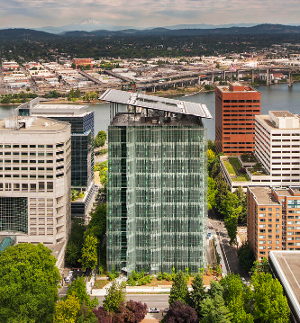Integrated Teaming - Edith Green-Wendell Wyatt Project Team
 The Edith Green - Wendell Wyatt (EGWW) Federal Building, a 512,000 gross square foot federal building in Portland, OR, underwent a modernization starting in December 2009 to transform a relatively conventional mid-seventies building into a LEED Platinum project that is on track to become one of the highest-performance federal buildings in the GSA’s portfolio.
The Edith Green - Wendell Wyatt (EGWW) Federal Building, a 512,000 gross square foot federal building in Portland, OR, underwent a modernization starting in December 2009 to transform a relatively conventional mid-seventies building into a LEED Platinum project that is on track to become one of the highest-performance federal buildings in the GSA’s portfolio.
Project-specific drivers of complexity included a geometrically intricate addition of floor plates to all sides of an existing building, demanding design and performance goals, and anticipating the needs of unknown tenants. The design strategy to add floor space and wrap a sophisticated layered facade around the existing building required a high level of coordination, technical expertise, and logistic effectiveness. New systems not commonly used in the United States added to the already-challenging technical issues. Another risk factor was the late identification of some tenants, which led to the need to incorporate their goals after the overall construction schedule was established. There were uncomplicated aspects of the project. The original building did not need to meet any preservation requirements and did not need to remain operational during construction. Overall, the project was identified as high risk (but with the potential for high payoff), leading the GSA to place extraordinary emphasis on planning and preparing for complexity.
Extensive early planning was the foundation for an extremely strong team culture that influenced every aspect of the project, from leadership strategies to logistical and process tools. Achieving the project goals while meeting budget and schedule constraints was the result of many good decisions by the team. The large number of positive outcomes and process innovations were tracked by the team to better understand how this project could be a model for the GSA and to the building industry as a whole.
Best Practices and Lessons Learned
- The project team placed an emphasis on identifying team members who would share core values and commit to the high-performance goals. Prior to selecting the general contractor, the project team held an in-person workshop for those contractors intending to submit proposals to create interaction and develop shared values.
- Building performance verification post-occupancy should be budgeted upfront in the project. The EGWW project team was able to use funds captured from unspent contingency for several core team members to focus on “after-care” work to ensure the building was meeting performance requirements.
- During value engineering, the EGWW project team used a “buy back” process that created a prioritized list of items to add back into the project scope, as budget and schedule allowed.
- The EGWW team estimated a $940,000 savings in project costs because of the reduction in the hours spent on design documentation made possible by integration—from a typical schedule of 53,000 hours over twenty-four months to 44,000 hours over fifteen months.
Commercial Strategies
- CMc+6 Custom contract
- Guaranteed maximum price contract
- Performance goals established by teams but not in contract
Leadership Strategies
- Investment in up-front team building and on-boarding
- GSA project leadership championed integrated project culture
- Subcontractor and manufacturer involvement
Logistical and Process Tactics
- Master and mini-master schedules
- Co-location with a shared information room (iRoom)
- BIM snapshots aligned with design milestones
- Process flowcharts

 U.S. General Services Administration
U.S. General Services Administration